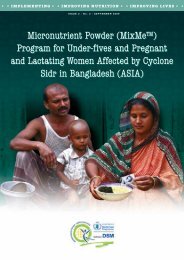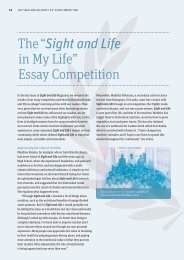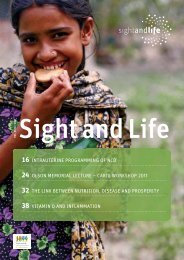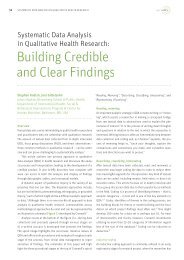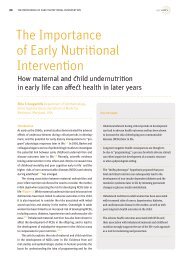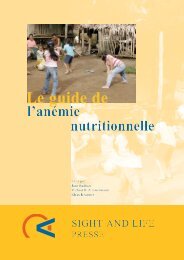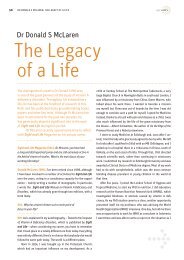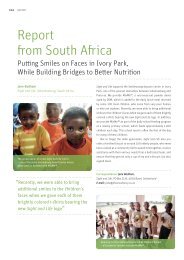Sight and Life Magazine 1/2011
Sight and Life Magazine 1/2011
Sight and Life Magazine 1/2011
You also want an ePaper? Increase the reach of your titles
YUMPU automatically turns print PDFs into web optimized ePapers that Google loves.
86 WHAT'S NEWFood <strong>and</strong> nutrition security is also an essential element of effectivecare <strong>and</strong> support in HIV-affected households <strong>and</strong> communities.In low-income countries, HIV contributes to foodinsecurity <strong>and</strong> malnutrition <strong>and</strong> has consequences for entirecommunities <strong>and</strong> societies, with the potential to significantlyslow down economic development. Livelihoods are disruptedas PLHIV lose the ability to work, which exacerbates food insecurity,<strong>and</strong> they <strong>and</strong> their families are often excluded frominformal safety nets because of the stigma associated withthe disease.Food insecurity frequently places people, especially women<strong>and</strong> girls, in situations that make them more vulnerableto transmission. It can lead to behaviors that have negativeconsequences, such as selling assets, removing children fromschool, migrating <strong>and</strong> engaging in transactional sex. Thesebehaviors exact a substantial price in the long term, includingincreased exposure to HIV. Mitigating food insecurity can,therefore, contribute to a reduction in the risk of transmission.All these elements highlight the importance of appropriatepolicy <strong>and</strong> programs to ensure the integration of food <strong>and</strong>nutrition in HIV <strong>and</strong> co-infection program design <strong>and</strong> implementation,with reference to the related reality that effectivefood <strong>and</strong> nutrition security programming must also beHIV-sensitive.All aspects of UNAIDS work are directed bythe following guiding principles:> aligned to national stakeholders’ priorities;> based on the meaningful <strong>and</strong> measurable involvement ofcivil society, especially people living with HIV <strong>and</strong>populations most at risk of HIV infection;> based on human rights <strong>and</strong> gender equality;> based on the best available scientific evidence <strong>and</strong>technical knowledge;> promoting comprehensive responses to AIDS that integrateprevention, treatment, care <strong>and</strong> support; <strong>and</strong>> based on the principle of non-discrimination.To access the UNAIDS Strategy <strong>2011</strong>-2015, go towww.unaids.org/en/strategygoalsby2015/International Food Policy Research Institute– Making the Link between Agriculture07tritionEconomic growth, which many assume has a natural positiveimpact on nutritional status through increased incomes <strong>and</strong>food expenditures, has not translated into improved nutritionin a number of developing countries. Considering this disconnect,IFPRI has released an important paper entitled “Thenexus between agriculture <strong>and</strong> nutrition – Do growth patterns<strong>and</strong> conditional factors matter?” This seeks to provide anoverview of the complex <strong>and</strong> dynamic relationship betweennutrition <strong>and</strong> growth, examine how different growthpatterns lead to different nutritional outcomes, <strong>and</strong> identifythe factors that influence the magnitude of this relationship.It aims to offer researchers insights on areas for future research<strong>and</strong> analysis <strong>and</strong> to provide policymakers withknowledge regarding potential development strategies <strong>and</strong>investment policies that will increase the likelihood ofpositive nutritional outcomes.As globally we try to break down the individual silos thatnutrition <strong>and</strong> agriculture have built <strong>and</strong> functioned within,<strong>and</strong> in light of the growth of the Scaling Up Nutrition (SUN)movement, this paper is important. It will hopefully lead tomany meaningful discussions <strong>and</strong>, more importantly, agriculturalgrowth that leads not only to increased production <strong>and</strong>reduced poverty, but also to improved nutrition.The paper can be accessed at www.ifpri.org/publication/nexus-between-agriculture-<strong>and</strong>-nutrition-0



